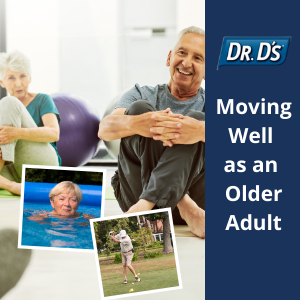
Moving Well as an Older Adult
Share
I find that many patients as they age become fearful of movement, particularly if they are dealing with arthritis. I decided to write this blog as a summary of some recommendations and guidelines for physical activity in adults over 65 years of age, including those suffering from arthritis. The hope is to inspire movement, end the fear, encourage healthy living, and ultimately try to prevent chronic disease.
Canadian Physical Activity Guidelines for adults 65 years + recommend accumulating at least 2.5 hours of moderate-to-vigorous-intensity aerobic activity per week in bouts of at least 10 minutes.
If you follow these guidelines you can help reduce your risk of chronic disease such as:
- high blood pressure
- heart disease
- stroke
- osteoporosis
- type 2 diabetes
- some cancers
- premature death
The benefits of exercise really cannot be overstated as it can also help you to:
- maintain independence,
- mobility,
- bone health
- improve body weight
- and mental health.
Examples of moderate-intensity activities include brisk walking and bicycling and should cause you to sweat a little and to breathe a little heavier (as in, you would be able to talk, but not sing).
Examples of vigorous-intensity activities include more intensive activities like cross-country skiing, jogging or swimming and these will cause you to sweat and be “out of breath” and not be able to speak.
They also suggest adding muscle and bone strengthening activities at least 2 days per week.
Examples of muscle strengthening activities include climbing stairs, digging in the garden, lifting weights, push-ups and curl-ups.
Examples of bone-strengthening activities include walking and running.
Those with poor mobility should include activities to enhance balance in order to help prevent falls such as tai chi and yoga.
Many patients suffering from arthritis admit their fear of movement, most often because they are worried about damaging their joint(s) further. However, the opposite can be true!
Gentle exercise actually:
- reduces inflammation and increases circulation
- lubricates the joint, making future motion easier and less painful
- keeps muscles stabilizing the joint strong and healthy, which can help combat further deterioration of the joint
The CDC released tips for safe physical activity, known as S.M.A.R.T. tips:
Start low, go slow.
- When starting or increasing physical activity, start slow and pay attention to how your body responds. With arthritis, it may take more time for the body to adjust. If you are not already active, start with a small amount at first, like 3 to 5 minutes 2 times a day. Add activity in small increments at a time (such as 10 minutes intervals) and allow time for your body to adjust to/recovery from the new level before adding more activity.
Modify activity when arthritis symptoms increase, try to stay active.
- Arthritis symptoms (such as pain, stiffness, and fatigue) may come and go. Modify your activity (ie. the type, intensity or duration) to stay as active as possible without making your symptoms worse when you are having a “bad day”.
Activities should be “joint friendly.”
- Walking, bicycling, water aerobics, or dancing are good examples as these activities have a low risk of injury and do not twist or “pound” the joints too much.
Recognize safe places and ways to be active.
- Safety is important for starting and maintaining an activity plan. If you are currently inactive or you are not sure how to start, a (virtual) exercise class may be a good place to start. If you plan your own activity, find safe places to be active. For example, walk in an area where the sidewalks or pathways are level and free of obstructions, are well-lighted, and are separated from heavy traffic.
Talk to a health professional or certified exercise specialist.
- Health care professionals and certified exercise professionals can answer your questions about how much and what types of activity match your abilities and health goals.
In fact, you should see a doctor if you experience any of the following:
- Pain that is sharp, stabbing, and constant
- Pain that causes you to limp
- Pain that lasts more than 2 hours after exercise or gets worse at night
- Pain or swelling that does not get better with rest, medication, or hot or cold packs
- Large increases in swelling or your joints feel “hot” or are red
As you can imagine, the more physical activity you participate in, the greater the health benefits. But like I always say to my patients, do your best, especially considering the constraints given the pandemic. 10 minutes of exercise is better than none at all. Here are some examples of ways you can incorporate physical activity in your day:
- Walk wherever and whenever you can
- Take the stairs instead of the elevator, when possible
- Carry your groceries home, if safe to!
Muscle tension, mild fatigue and aches during and after exercise are to be expected but remember to start slowly and listen to your body. If something feels off or wrong, don’t push yourself and speak to your medical doctor, especially if you have not been active.